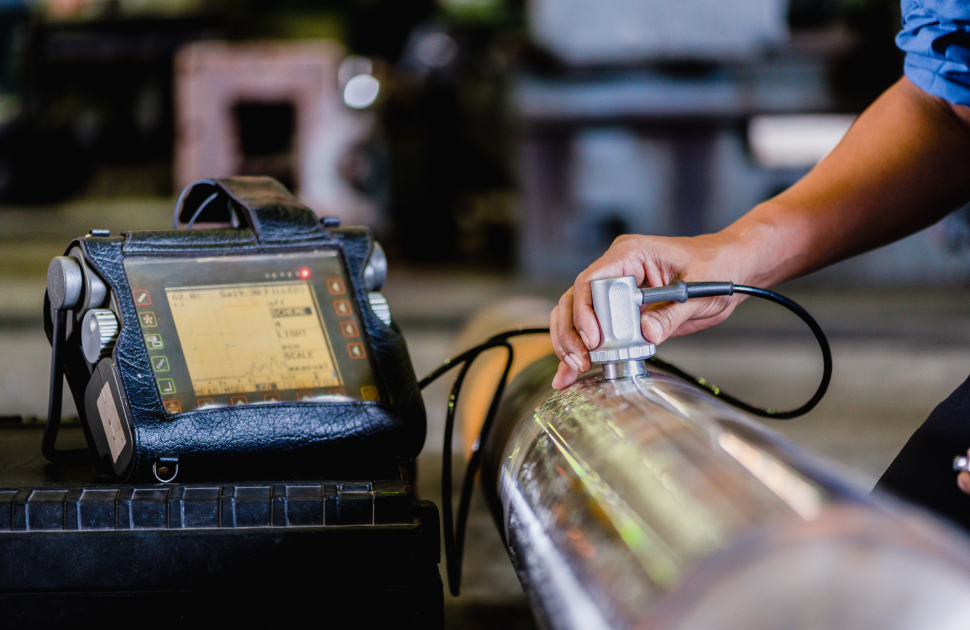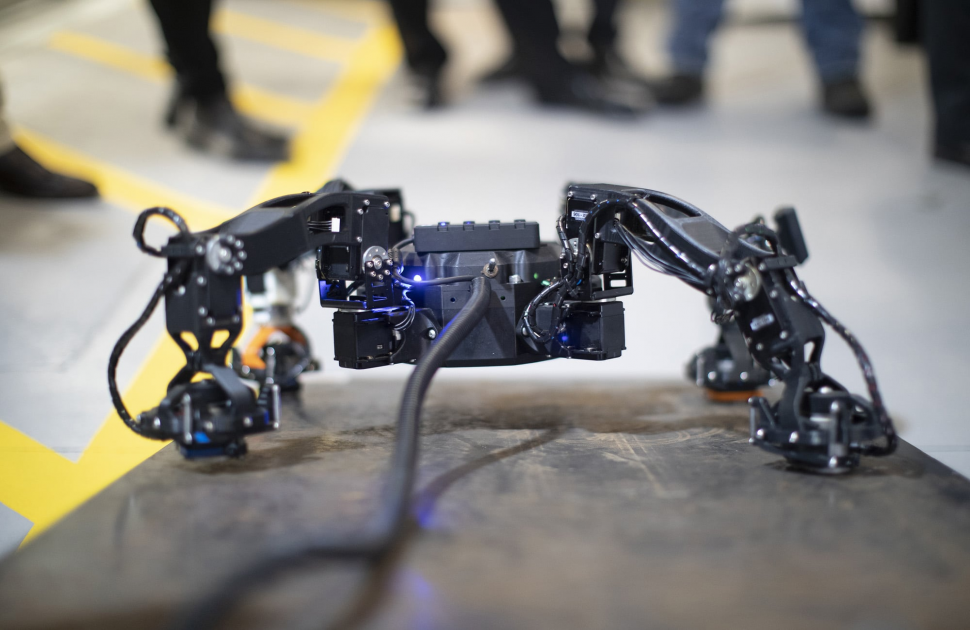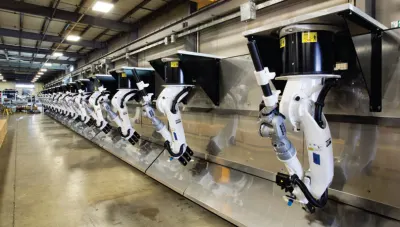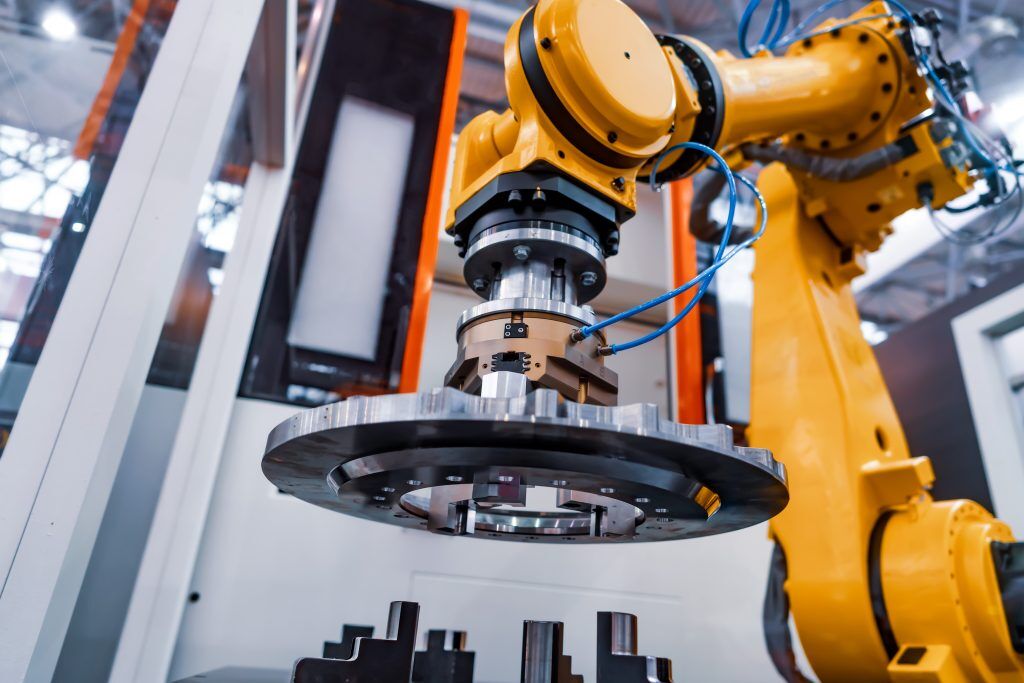Introduction
- Understanding Non-destructive Testing
- Robotics in NDT
- Types of Robotic Systems in NDT
- Why is Robotics Equipment popular in NDT?
- The Growth of Robotics Industries
- Emergence of Robotic Systems in NDT
- Robotic Systems in NDT Applications
- Advantages of Robotic systems in NDT
- Constraints of Robotic Systems in NDT
- Conclusion
- Key Takeaways
Focusing on automation is the next big step in improving the testing efficiency and, in particular, reliability in NDT.
There are numerous handling and manipulation operations associated with automatic testing, which can now be replaced by robots.
Robotic equipment in NDT represents a technological revolution that promises to significantly enhance safety and efficiency.
These robots, equipped with advanced sensors, cameras, and AI algorithms, can perform inspections in hazardous, hard-to-reach, or repetitive environments.
This article explores the reasons why robotics equipment is becoming increasingly popular in NDT, supported by real-world examples of robots used in different NDT applications across industries.
Understanding Non-destructive Testing
Non-destructive Testing (NDT) is a technique used in industry to analyze the properties of a component, system, material, or structure for characteristic variations, welding faults, and discontinuities without causing damage to the original part.
Non-destructive testing (NDT) is also called Non-destructive Examination (NDE) or non-destructive inspection (NDI).

Robotics in NDT
Traditionally, NDT has relied heavily on human inspectors who manually carry out inspections using various testing methods.
While human inspectors are invaluable for their expertise, these methods are often time-consuming, labor-intensive, and have some inherent limitations, including fatigue, potential for error, and safety concerns, especially when working in hazardous environments.
These challenges have led to a growing demand for automation and the integration of robotics and Artificial Intelligence (AI) in NDT.
Employing Robots has several advantages, beginning with multipurpose use with relatively good precision and finishing with a low cost.
Aside from simple manipulation and specific picking activities, the robotic arm can be utilized for surface scanning and vision-driven applications, with various types of probes and measuring equipment.
Customers are increasingly requesting automated systems in which guided robotic devices undertake automated activities.
Most consumers need a fully automated procedure, ideally without any human intervention.
The use of guided robotic systems in conjunction with automated evaluation is in the spirit of NDE Industry 4.0.
Types of Robotic Systems in NDT
Robotic systems have revolutionized the field of Non-Destructive Testing by enhancing inspection capabilities, increasing efficiency, and ensuring the safety of inspectors.
These automated systems are designed to perform inspections in challenging environments, such as those with extreme temperatures, confined spaces, or hazardous materials.
Here are some key types of robotic systems commonly used in NDT:
- Remote Operated Vehicles (ROVs)
ROVs are often used in underwater and subsea inspections.
These remotely controlled machines can access and inspect underwater structures, pipelines, and ship hulls.
Equipped with various sensors, cameras, and NDT tools, ROVs can capture images, perform ultrasonic thickness measurements, and even conduct Magnetic Particle Testing in submerged environments.
- Unmanned Aerial Vehicles (UAVs)
Drones, or UAVs, are gaining popularity for aerial inspections of large structures like bridges, wind turbines, and industrial facilities.
Equipped with high-resolution cameras and Thermal Imaging Technology, UAVs capture visual data, infrared images, and other data that help identify structural defects or anomalies.
- Crawlers and Climbers
These robotic systems are designed to navigate and inspect challenging terrains and structures.
Crawlers can move along pipes, tanks, or the interior of vessels, conducting ultrasonic or Visual Inspections.
Climbing robots can ascend vertical surfaces, like the walls of storage tanks, and perform detailed inspections.

- Magnetic Crawlers
They are used primarily in the Oil and Gas Industry, magnetic crawlers can move along the exterior of pipes or tanks, performing magnetic particle testing and Ultrasonic Thickness Measurements to detect corrosion or defects.
- Autonomous Underwater Vehicles (AUVs)
These underwater robots are often used in marine applications to inspect ship hulls, Pipelines, and subsea structures.
AUVs are equipped with a range of sensors and cameras to provide comprehensive data for analysis.
- Robotic Arms
These versatile robots are equipped with NDT sensors and can be deployed in various industries, including aerospace and manufacturing.
They can perform inspections on complex components, like aircraft engines or welds, with precision.
- Collaborative Robots (Cobots)
Cobots are designed to work alongside human inspectors, enhancing their capabilities and improving safety.
They can handle various NDT tools, such as Ultrasonic Testing or eddy current probes, while the operator guides the inspection process.
Robotic systems in NDT offer numerous advantages, including increased efficiency, reduced human exposure to hazardous environments, and access to difficult-to-reach areas.
These systems are instrumental in maintaining the safety and integrity of critical infrastructure across various industries.
As technology continues to advance, the capabilities of robotic NDT systems are expanding making inspections more reliable and cost-effective.
Why is Robotics Equipment popular in NDT?
Robotics equipment has become increasingly popular in the field of Non-destructive Testing (NDT) due to its ability to perform inspections in hazardous or hard-to-reach environments, reducing the risk to human inspectors and enhancing efficiency.
This technology is revolutionizing the way NDT is conducted across various industries, including aerospace, nuclear, Oil and gas Industry, etc.
- Improved Safety
One of the primary reasons for the popularity of robotics in NDT is improved safety.
NDT inspections often take place in challenging environments, such as confined spaces, extreme temperatures, or areas with exposure to hazardous materials.
In these situations, there exists a significant risk to human inspectors. Robots can take over these dangerous tasks, minimizing the potential for accidents and ensuring the safety of human workers.
For example, the Inuktun Versatrax™ is a remotely operated vehicle (ROV) designed for inspections in confined spaces and underwater environments.
It's widely used for inspecting pipelines, tanks, and nuclear facilities, reducing the need for human entry into hazardous areas and thereby ensuring their safety.
- Enhanced Precision and Consistency
Robotic equipment in NDT offers a level of precision and consistency that is challenging to achieve with human inspection.
They are equipped with advanced imaging and sensor technologies that provide high-resolution data for analysis.
Robots are not susceptible to fatigue, and their movements are highly controlled, ensuring that inspections are conducted with the same level of accuracy and repeatability, even in long and monotonous tasks.
For example, in the Oil and gas Industry, robots equipped with advanced ultrasonic sensors are used to inspect pipelines for defects and corrosion.
These robots can move along the length of the channel, capturing detailed images and data that can be used to assess the structural integrity of the pipeline.
In the automotive industry, robots equipped with advanced vision systems are used for the Automated Inspection of weldings, paint quality, and assembly processes.
These robots ensure that every vehicle meets stringent quality standards.
- Cost Savings
While the initial investment in robotic equipment can be substantial, it often leads to significant cost savings in the long run.
Robots can work 24/7 without the need for breaks, reducing labor costs.
Additionally, they can perform inspections more quickly, reducing downtime and improving operational efficiency.
In the Oil and Gas Industry, remotely operated vehicles (ROVs) are used to inspect underwater pipelines and structures.
These robots can quickly identify defects, preventing costly oil spills and ensuring the integrity of critical infrastructure.
- Access to Hard-to-Reach Areas
Certain NDT inspections require access to areas that are difficult or dangerous for human inspectors to reach.
Robots are designed to navigate complex structures, crawl through narrow spaces, and even perform tasks in extreme conditions.
This access to hard-to-reach areas ensures that no critical inspection is compromised due to inaccessibility.
For instance, in the Aerospace Industry, robots are used to inspect aircraft components, such as wings and fuselage, where human access can be challenging.
These robots are equipped with Advanced Sensors and imaging systems that allow them to capture detailed data for analysis.
In Nuclear Power Plants, robots play a crucial role in inspecting components within the reactor, where radiation levels can be extremely high.
These robots are designed to withstand harsh environments and can navigate complex structures to perform thorough inspections.
By using robots, the need for human inspectors to enter potentially hazardous areas is greatly reduced, ensuring their safety.
Crawling robots are used in the inspection of bridges and tunnels.
They can traverse the undersides of structures, assessing their condition and identifying any signs of deterioration without the need for expensive scaffolding or putting workers at risk.
- Provides Real-Time Data
Another significant advantage of using robotics Equipment in NDT is the ability to perform inspections in real-time or near real-time.
This means that data can be collected and analyzed on-site, allowing for immediate decision-making.
As a result, robotic equipment provides a significant advantage in applications where timely assessment is crucial, such as in emergency response situations or critical infrastructure inspections.
One notable example is the use of Remotely Operated Vehicles (ROVs) in underwater inspections for offshore structures in the oil and gas industry.
These ROVs are equipped with advanced imaging systems and can be deployed to inspect underwater pipelines, risers, and subsea structures.
The data collected by these ROVs is transmitted in real-time to operators on the surface, allowing for immediate analysis and decision-making.
The Growth of Robotics Industries
The robotics industry has witnessed remarkable growth in recent years, with widespread applications across various sectors.
This expansion is primarily attributed to advancements in technology, increased automation needs, and the pursuit of efficiency and precision.
In manufacturing, robots have become essential for tasks ranging from assembly to quality control, boosting production rates and product consistency.
The healthcare industry benefits from surgical robots that enhance the precision of medical procedures.
Furthermore, logistics and warehousing have seen a surge in robotics adoption to meet the demands of e-commerce and efficient supply chain management.
The growth of the robotics industry is also apparent in agriculture, where autonomous machines are revolutionizing farming practices, and in service sectors with the deployment of robots for customer service and data analysis.
As Artificial Intelligence and machine learning continue to evolve, the possibilities for robotics are limitless, promising further expansion in areas like self-driving vehicles, space exploration, and advanced artificial intelligence applications.
This dynamic growth reflects the enduring importance of robotics in driving innovation and improving various aspects of our lives.

Emergence of Robotic Systems in NDT
The emergence of robotic systems in Non-destructive Testing (NDT) represents a transformative shift in the way inspections are conducted across industries.
Robotic NDT systems are designed to navigate challenging environments, including Confined Spaces, extreme temperatures, or hazardous conditions, making inspections safer and more efficient.
These robotic systems are equipped with a variety of sensors and NDT tools, such as ultrasonic, Eddy Current Testing, or visual inspection devices, enabling them to detect defects or anomalies in structures and components.
They excel in conducting inspections on critical infrastructure like pipelines, bridges, aerospace components, and underwater structures, where human access is difficult or risky.
The integration of Artificial Intelligence and machine learning further enhances the capabilities of these robots, allowing them to autonomously analyze data and make real-time decisions.
As a result, robotic NDT systems not only improve inspection accuracy but also reduce downtime and operational costs.
Their emergence signifies a new era of NDT, where technology and automation combine to ensure the safety, reliability, and efficiency of critical assets.
Robotic Systems in NDT Applications
If robots can achieve the fundamental requirements of automated NDT Testing—data gathering, repeatability, accuracy, and precision—they can aid in advanced NDT Techniques.
The required data capture speed is a barrier to deploying industrial robots for NDT Applications.
The automated inspection system's basic component is an inspection cell consisting of two six-axis robot arms.
The robot's movement and the capture of the ultrasound signal are synchronized using in-house software.
The operator can select the areas to be inspected by loading the inspected component geometry CAD file into a software program.
Then, the robot's scan path is generated by the software. Here are the major applications of robots in NDT:
- Pipeline Inspection
The inspection of pipelines, whether they transport oil and gas, water, or other fluids, is crucial to prevent leaks and environmental damage.
Robots have revolutionized Pipeline Inspection by providing access to long stretches of pipelines and identifying defects or corrosion.
The Inuktun MaggHD™ is an example of a robot used for Pipeline Inspection.
It can crawl through pipelines of various sizes and inspect for corrosion, cracks, or blockages, ensuring the integrity of the pipeline.
- Nuclear Industry
The nuclear industry presents one of the most challenging environments for inspections due to radiation exposure.
Robots equipped with specialized sensors and cameras are used for inspecting nuclear facilities, ensuring the safety of human operators and the reliability of critical equipment.
The WOLF-ROBSCAN® is a radiation-resistant robot used for inspections in Nuclear Power Plants.
It can navigate radioactive areas, inspect equipment, and provide valuable data for maintenance and safety.
- Underwater Inspections
Inspections of underwater structures, such as offshore oil rigs, bridges, and ship hulls, can be extremely hazardous.
Remotely operated vehicles (ROVs) and autonomous underwater vehicles (AUVs) are employed to perform inspections beneath the water's surface.
The BlueROV2 is an ROV used for various underwater inspections, including assessing the condition of offshore structures and the search for shipwrecks.
Its agility and advanced cameras enable precise inspections.
- Aerospace Industry
In the Aerospace Industry, ensuring the safety of aircraft is paramount.
Robots are used to inspect aircraft components, including engines, wings, and fuselage, for defects or damage.
This level of precision is critical in maintaining the integrity of aircraft.
The Elbit Hermes 900 is an unmanned aerial vehicle (UAV) used for Aerial Inspections of Aircraft.
It can fly close to the aircraft, capturing high-resolution images and assessing its condition.
- Automotive Quality Control
The automotive industry relies on robots for quality control and inspection of vehicles during the manufacturing process.
These robots use advanced vision systems to identify any defects in the body, paint, or assembly of the vehicle.
ABB's FlexInspect™ robot is used in automotive assembly lines for quality control.
Equipped with cameras and advanced algorithms, it inspects the body of the vehicle for any imperfections, ensuring that only high-quality cars reach the market.
In addition to improving safety and efficiency, robotics equipment in NDT also enhances the quality and consistency of inspections.
Unlike human inspectors, robots do not experience fatigue, which can lead to decreased attention to detail.
They can work continuously for extended periods, ensuring thorough and consistent inspections.
This is particularly important in industries where high precision and accuracy are critical, such as aerospace and nuclear.
Moreover, robotics equipment can be equipped with Advanced Artificial Intelligence (AI) algorithms for automated defect detection.
These algorithms can analyze the data collected during inspections and identify anomalies or defects with a high level of accuracy.
This significantly reduces the reliance on human interpretation and minimizes the chances of overlooking critical defects.

- Magnetic flux leakage (MFL) test
Magnetic Flux Leakage (MFL) testing is a non-destructive testing (NDT) technique used to detect flaws in materials, particularly in the magnetized state.
It involves measuring the magnetic field passing through a test piece and detecting any deviations indicative of cracks, holes, or other defects.
Diakont’s Stingray service tool is equipped with water jets and power scrubbers to inspect the tank floor allowing the onboard magnetic flux leakage (MFL) test.
The crawler tools integrate Ultrasonic Testing (UT) and magnetic flux leakage (MFL) sensors To comply with industrial standards (API 653, EEMUA).
The position information is stored in every scan data, producing a comprehensive C-scan of the tank floor.
- Eddy Current Testing
Eddy Current Testing is a Non-destructive Testing (NDT) Technique used to detect cracks, corrosion, and other defects in materials.
It involves applying an alternating magnetic field to the material and measuring the resulting currents, which get altered due to the presence of defects.
Eddy Current Testing can be used on a wide range of materials, including metals and composites.
Robotic eddy current testing performs high-quality flaw detection in real-time with minimal or no human intervention.
- NDT in the Radiation Area
Toshiba has developed a robot that can withstand high radiation, making it capable of working in nuclear disaster sites, such as climbing over debris and venturing into radiated areas that are off-limits to humans.
- Ultrasonic Testing – Guided Wave Ultrasonic Testing
On offshore floating and semi-submersible structures, mooring lines are vital safety components.
Massive structural and environmental factors like storms, ocean waves, and currents frequently affect the lines.
Every link that needs to be tested has an NDT collar with ultrasonic probes placed around its entire circle by the MoorInspect robot.
The robot has the strength and capability to support a payload of up to 70 kg of sensors.
Crocells inspection robot is controlled wirelessly and deploys phased-array ultrasound to look for weld defects in tall steel structures.
- Visual Inspection
One of the most common applications of robotics in NDT is Visual Inspection.
The camera sensor head can be moved by the robot to the desired position.
The camera broadcasts high-quality video feeds and supports real-time picture analysis.
The Explorer robot has an articulated body that can travel long distances to generate high-resolution photographs of the surfaces of a pipe.
Advantages of Robotic systems in NDT
Real-time data analysis improves the effectiveness and convenience of structural integrity operations.
Robotic tool inspections can incorporate an immediate reporting threshold.
Continuous monitoring enables tool maintenance and/or inspection scope modification.
Real-time data monitoring enables daily reporting and the creation of a preliminary report (including just the most important anomalies).
Constraints of Robotic Systems in NDT
When compared to manual inspection, the initial cost and operating expenditures are significantly higher.
Because of the complicated geometry of the components, robot hardware is necessary.
Each application will require its robot software program. It is vital to interface hardware and software programs.
It is also necessary to have a sufficient number of trained personnel for robot applications in Non-destructive Testing. Machine security must be assured.
Conclusion
The popularity of robotics in NDT can be attributed to its ability to access hazardous environments, provide high-quality data, enable real-time inspections, enhance safety, and improve inspection consistency.
With continuous advancements in technology, there would be even more sophisticated robotics equipment tailored for specific NDT Applications, further revolutionizing the inspection process across various industries.
As industries continue to recognize the benefits of Integrating Robotics in NDT, there’s a continued growth in its adoption and a transformation in the way inspections are conducted.
Key Takeaways
- Robotics equipment is revolutionizing Non-destructive Testing (NDT) by enhancing efficiency, safety, and precision in inspections.
- Robotic systems equipped with advanced sensors, cameras, and Artificial Intelligence algorithms can perform inspections in hazardous, hard-to-reach, or repetitive environments.
- The use of robotics in NDT improves safety by reducing human exposure to dangerous conditions, such as confined spaces, extreme temperatures, and areas with hazardous materials.
- Robots offer enhanced precision and consistency in inspections, as they do not experience fatigue and can work continuously with controlled movements.
- Robotic systems provide access to hard-to-reach areas, ensuring that critical inspections are not compromised due to inaccessibility.
- Real-time data analysis is a significant advantage of using robotics in NDT, allowing for immediate decision-making in emergency response situations or critical infrastructure inspections.
- The growth of the robotics industry is driven by advancements in Non-destructive Evaluation Technology, increased automation needs, and the pursuit of efficiency and precision across various sectors.
- Specific applications of robotics in NDT include Pipeline Inspection, nuclear industry inspections, underwater inspections, aerospace component inspections, automotive quality control, and more.
- Robotic systems in NDT have some constraints, including higher initial and operating costs, the need for specialized hardware and software, and the requirement for trained personnel.
- Despite the initial challenges, the continued Integration of Robotics in NDT is transforming the inspection process and improving the reliability and safety of critical infrastructure in various industries.
References:
1.Tech Briefs
2. Get It Made









